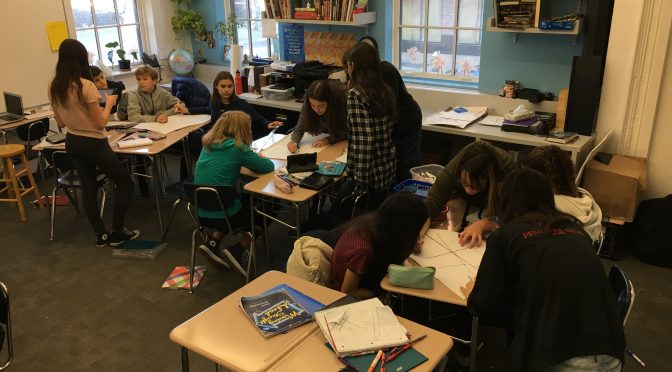Everyone is moving so fast from task to task. Sixty minutes surely flies by and 45 minutes sometimes feels like a blink. My plan book details the activities of each math class but I’m not always sure of my students’ experiences or what they REALLY gain in the time we spend together. Many things pull at their attention: the humanities presentation they just gave, the science test next class, the basketball game at 3:30pm. Hence, I’ve initiated a self-study about examining how best I pause to gather information about what my students know at any given point (formative assessment) and how math class is really going for them.
Some questions I’ve asked myself as I begin this process:
Do I offer students enough opportunities to show what they know?
What are those opportunities?
What about feedback? How quick and how often do I give it?
Do I listen and observe enough?
What about student self-assessment?
As you would imagine, resources are in abundance: blogs, articles, books, apps, colleagues, etc.… I’ve had to remind myself to be careful and thoughtful about the implementation of new routines and new technology so as not to overwhelm or confuse students. They respond to consistency. Perhaps through this process, I’ll also learn how I can better help students think about and document their math learning. One of the first steps: I had students make a simple video using an iPad app called Educreations. It allows the students to record their thinking to a problem while writing on the screen, which acts like a “whiteboard.” You don’t see the student. You only see the writing. One student’s reaction, “That’s cool but not so easy. You really need to slow down and think about what you want to say. I messed up twice but now I got it.” Hmmm…as I continue this work I need to remember to give myself the space to mess up.


Michelle, thanks for posting and for sharing the focus of your self-study. One of the things that your post has me thinking about is the value of framing what we do around learning and less about teaching. In making this shift, I think it also provides a way for us to slow down and think about time more positively (i.e., not that we don’t have enough of it, but how do we make sure that we are using it for the right purposes). I also think that the more we examine ourselves as learners (i.e., what am I learning about myself as a learner and my students as co-learners with me) the more likely we are to really seek out the information that helps us to make progress as a learner. I think this also helps us to better see the dynamic nature of how we assess and what we asses for (i.e., assessment of learning and assessment for learning, which we need not see as an either/or, but an and/both). I look forward to reading about future insights.
Thanks for the reminder, Michelle. I suspect that most teachers have experienced anxiety over feebly attempting to present an unrealistic Mary Poppins-esque facade. As life long learners, we, too, must slow down, experience bumps in the road, re-evaluate, and continue on.
Sometimes I find that when I tell my students that I’m going to experiment with something new, and that I’m not even sure if it will work, they are more willing than ever to go along with the ride. If I open myself up to making mistakes, my hope is that my students will open themselves up too. And in the process, I hope we are all reminded that slowing down, making mistakes, and persevering are all necessary parts of continued growth and learning.
I love that a lesson like permission to mess up was delivered by a student reflecting on learning after messing up!